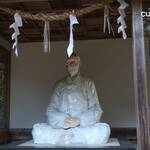The Enchanting World of Korean Ceramics
The Rich Heritage of Korean Pottery
 The history of Korean ceramics is a captivating journey that stretches back to prehistory, beginning with simple brown wares adorned with geometric incisions. Influenced by the techniques of their Chinese counterparts, Korean potters soon developed their own distinctive and highly sought-after styles, including grey stoneware, celadon (or greenware), buncheong ware, and white porcelain. The innovative designs range from intricately detailed incense burners to the sublime simplicity of the maebyeong vase. Korean pottery often features decorations inspired by plants, flowers, and wildlife, and reflects the country’s rich religious heritage, showcasing both Buddhist motifs and minimalist Confucian designs.
The history of Korean ceramics is a captivating journey that stretches back to prehistory, beginning with simple brown wares adorned with geometric incisions. Influenced by the techniques of their Chinese counterparts, Korean potters soon developed their own distinctive and highly sought-after styles, including grey stoneware, celadon (or greenware), buncheong ware, and white porcelain. The innovative designs range from intricately detailed incense burners to the sublime simplicity of the maebyeong vase. Korean pottery often features decorations inspired by plants, flowers, and wildlife, and reflects the country’s rich religious heritage, showcasing both Buddhist motifs and minimalist Confucian designs.
The Evolution of Korean Ceramics Through the Ages

The story of Korean ceramics begins during the Three Kingdoms of Korea (57 BC-668 AD)—Silla, Goguryeo, and Baekje. These early periods saw the production of rough domestic wares from numerous kilns. They also created sophisticated statues of royal figures, guardians, and horses, comparable to Chinese Han Dynasty figures. These statues served domestic and imperial votive shrines and acted as escorts for the deceased in the tombs of nobles and kings. These early works were crafted using both the potter’s wheel and the traditional hammered clay and coil method.
The Golden Age of Koryo Celadon
The nearly five centuries of the Koryô dynasty (918–1392) are often considered the golden age of Korean ceramics, particularly for the exquisite celadon pottery. This period saw the creation of highly vitrified glazes in a stunning grey-green color, achieved through the presence of iron in the clay and the careful balance of iron oxide, manganese oxide, and quartz particles in the glaze, combined with precise firing conditions. The early Koryô celadon pieces are notable for their elegant forms and the absence of surface decoration, highlighting the beauty of the glaze itself. By the late 11th and early 12th centuries, these master potters began to experiment with carved and incised decorations under the translucent sea-green glaze, creating pieces that remain unparalleled in their beauty and craftsmanship.
The Ceramic War: A Tumultuous Chapter in Korean Ceramic History
In the late 16th century, the serene and flourishing world of Korean ceramics faced an unprecedented upheaval during the Imjin War (1592-1598), also known as the Japanese invasions of Korea. This period marked a tragic end to Korea’s golden age of ceramics, as the country endured severe destruction, and many of its master potters were either killed or abducted by Japanese forces.
The Invasion and Its Impact on Korean Artisans
Japan, under the leadership of Toyotomi Hideyoshi, launched a series of invasions with the ambition of conquering Korea and using it as a springboard to invade China. The conflict devastated Korea’s cultural landscape, but one of the most significant and often overlooked aspects of this war was the targeted abduction of Korean ceramic artists. Recognizing the extraordinary skill and craftsmanship of Korean potters, the Japanese invaders sought to capture these artisans to enhance their own ceramic industry, which was then in its developmental stages.
During the invasions, many Korean kilns were destroyed, and countless pieces of pottery were lost forever. However, the most tragic consequence was the forced relocation of hundreds of Korean potters to Japan. These skilled artisans were taken to various regions in Japan, including Arita, Hagi, and Satsuma, where they were compelled to establish kilns and share their techniques with Japanese craftsmen.
The Birth of Japanese Porcelain
 The Korean potters’ expertise significantly influenced the development of Japanese ceramics, leading to the birth of Japanese porcelain. In Arita, for instance, the presence of Korean artisans like Yi Sam-pyeong (later known as Kanagae Sanbee) was instrumental in discovering the local kaolin deposits necessary for porcelain production. This discovery marked the beginning of the renowned Arita porcelain industry, which would later become famous worldwide.
The Korean potters’ expertise significantly influenced the development of Japanese ceramics, leading to the birth of Japanese porcelain. In Arita, for instance, the presence of Korean artisans like Yi Sam-pyeong (later known as Kanagae Sanbee) was instrumental in discovering the local kaolin deposits necessary for porcelain production. This discovery marked the beginning of the renowned Arita porcelain industry, which would later become famous worldwide.
While the Japanese ceramic industry flourished with the influx of Korean techniques and artistry, Korea’s ceramic tradition suffered a severe blow. The loss of so many master potters meant that the production of exquisite celadon and other traditional wares diminished significantly. The once vibrant kilns of Korea struggled to maintain their former glory, and the quality of ceramics produced during this period reflected the turmoil and loss experienced by the artisans and their communities.
A Legacy of Resilience and Revival
Despite the devastation, the spirit of Korean ceramic artistry was not entirely extinguished. The subsequent Joseon dynasty (1392-1897) saw efforts to revive the country’s ceramic heritage. Potters who remained in Korea continued to innovate and adapt, developing new styles and techniques that reflected both resilience and a deep-seated reverence for their craft. The introduction of buncheong ware and the refinement of white porcelain during the Joseon period are testaments to the enduring ingenuity and creativity of Korean potters.
Contemporary ceramic art.

Today, the story of the Ceramic War is a poignant reminder of the resilience of Korean artisans and the enduring impact of their craft. The legacy of those who were lost and those who continued their work under harrowing circumstances is evident in the timeless beauty and innovation that defines Korean ceramics. This chapter of history underscores the profound interconnectedness of cultures and the enduring power of art to transcend even the most tumultuous times.
Discover More About Korean Ceramics
Dive deeper into the fascinating history of Korean ceramics and uncover the stories behind these stunning creations. Visit the link below to learn more about this unique and enchanting art form. : Venice clay artists or ancient
If you’re passionate about Korean ceramics, join our community on Facebook for more insights and discussions. 在 Facebook 上.

